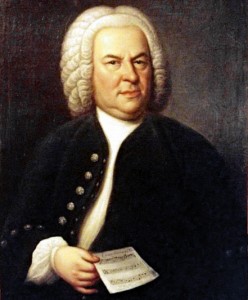Bach, French Suite No. 2 in C Minor
 I want to close out our discussion of the Baroque suite with the granddaddy of them all. As with many of the genres and styles of the Baroque era, J.S. Bach represents the culmination. Keep in mind that at the time Bach was demonstrating his mastery of these forms, the musical world was pursuing new paths and largely rejecting the “old” Baroque style. Bach lived to see his sons, writing in the new style, find fame and success that far exceeded his own.
I want to close out our discussion of the Baroque suite with the granddaddy of them all. As with many of the genres and styles of the Baroque era, J.S. Bach represents the culmination. Keep in mind that at the time Bach was demonstrating his mastery of these forms, the musical world was pursuing new paths and largely rejecting the “old” Baroque style. Bach lived to see his sons, writing in the new style, find fame and success that far exceeded his own.
Bach wrote four orchestral suites, suites for unaccompanied cello, and lute suites. For keyboard he wrote six English suites, six French suites, and six partitas. The keyboard partitas along with his sonatas and partitas for violin can be classified as suites as well. The terms “suite,” “sonata,” and “partita” were applied somewhat loosely. The classical sonata would replace the Baroque suite, but it would by then have some specific characteristics lacking in the Baroque sonata.
Bach did not label his keyboard suites as French or English, and there is no consistent trait that would make them clearly one or the other. That said, the English suites all begin with a prelude while the French suites do not. But the addition of the prelude probably originated in France. Confusing, right?
So let’s look for consistency in this: all of the English suites and French suites follow the pattern of Allemande, Courante, Sarabande, and Gigue with various other dances inserted between the Sarabande and Gigue.
This recording of the second French suite includes the score, so you can follow along. As a reminder, each dance has a binary form: an A section repeated and a B section repeated. Sometimes performers omit the repeats or, as here, they repeat the A section but not the B section.



